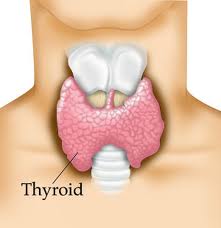As an endocrinologist, a common reason why people are referred to see me is for thyroid problems. Often, my patients ask me about the interpretation of their thyroid blood test results – they have been told that a test result is too high or too low, and often arrive in my office feeling confused about what it all means, and looking for some understanding of their lab values. So, I thought I’d provide an online reference here, to clarify what thyroid lab values actually mean.
Let’s start with the pituitary gland, which acts as the thermostat for the thyroid gland. The pituitary gland is located on the undersurface of the brain – it’s a small gland that is actually the control center for several hormone producing organs in the body.

The pituitary gland makes a hormone called Thyroid Stimulating Hormone, or TSH. TSH goes to the thyroid gland, and tells the thyroid gland to make thyroid hormone.
There are two types of thyroid hormone, called T4 and T3. The human thyroid gland makes mostly T4, and a little bit of T3. T4 enters inside every cell of our body, where each cell then turns T4 into T3. T3 is the active thyroid hormone that exerts thyroid effects, driving metabolism as well as numerous other functions in the body.
A very common condition is an underactive thyroid gland, also called hypothyroidism, or Hashimoto’s, if the cause of the low thyroid function is the immune system attacking the thyroid gland. If the thyroid is underproducing T4, think of it like it’s too cold in the room – you’d turn up the thermostat, right? Likewise, the TSH thermostat gets turned up – so TSH levels read high (in other words, the TSH level runs opposite to what the thyroid is doing – TSH goes up when thyroid function is low). In this setting, the T4 and T3 levels might read low, suggesting that there is a very underfunctioning thyroid gland; or, the T4 and T3 can be in the normal range, suggesting a more mildly underactive thyroid gland.
Conversely, when there is an overfunctioning thyroid gland, called hyperthyroidism, the TSH is low or undectable – just like you’d shut off the thermostat if the room was too hot. T4 and T3 can be high, or in the higher end of the normal lab range. Again note that the TSH runs opposite to what the thyroid levels are doing – patients often tell me they are confused because they have been told that their blood test is low (referring to the TSH) when this means that their thyroid is actually OVERactive.
It’s important to point out that the examples I just gave of under- and overactive thyroid are the most common lab results we see. There are also less common causes of thyroid problems; for example, if the pituitary ‘thermostat’ itself is not working properly to make the right amount of TSH, then the lab interpretation is quite different from the discussion above. Be sure to discuss your own thyroid test results with your doctor.
Dr Sue Pedersen www.drsue.ca © 2019
Follow me on Twitter for daily tips! @drsuepedersen












